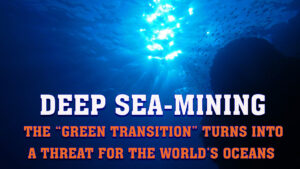With slogans like “environmental helper 5G”, mobile phone providers are trying to create the impression that the widespread introduction of the “dream team” 5G and digitalisation can avert rampant environmental destruction and global warming. But is this really the case?
5G: Accelerator of Dispersion and Digitalisation
In 2019, and earlier in certain countries, the roll-out of the 5th generation mobile phone standard (5G) began. Compared to 4G, it promises faster data transmission, shorter response times and higher energy efficiency through the use of the latest technologies. This expansion step is primarily justified by the strong increase in mobile data hunger, especially due to increasing video streaming, growing use of social media and constantly improving video quality (resolution and frame rate).1)Screen resolutions and video standards have developed considerably in recent decades. Early computer screens had a resolution of 640 x 480 pixels (video standard VGA). Today’s smartphones have a resolution of around 1440 x 3200 pixels, TV sets even up to 8192 x 4320 (8K resolution). The video qualities of the streaming services have changed accordingly: While a few kilobytes were initially sufficient (e.g. YouTube 144p), today several megabytes (e.g. Netflix Ultra HD, 4K) have to be transmitted per second. And there is no end in sight to this development.
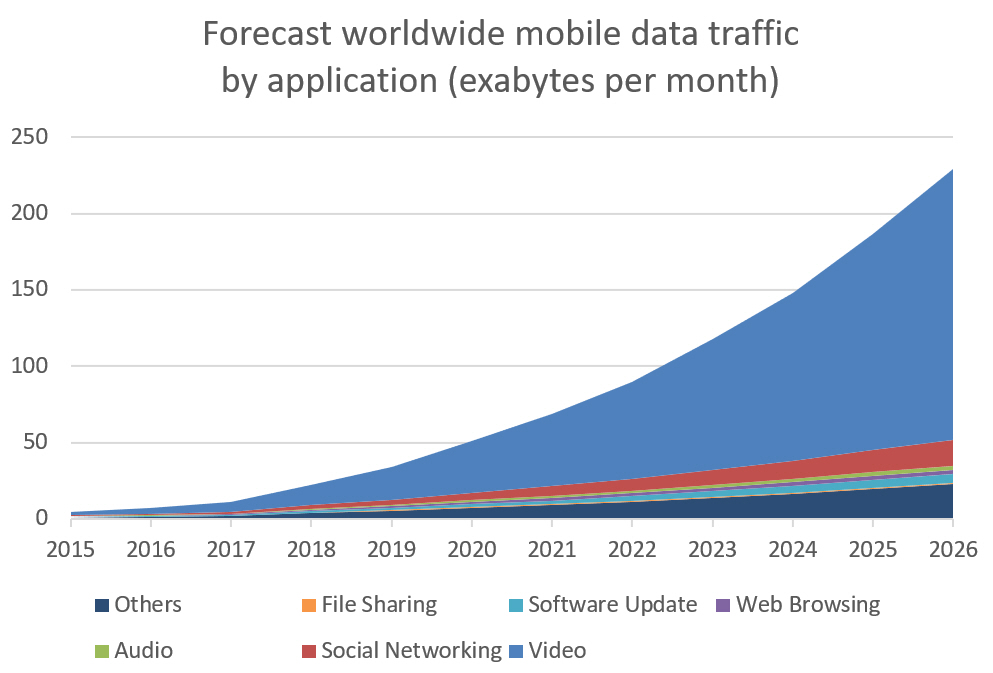
(Data source: Ericsson Mobility Visualizer, November 2020)
The share of video in mobile data traffic is already 68% today and is predicted rise to over 80% in the next 5 years according to forecasts by the mobile communications equipment supplier Ericsson. What most people do not know: Almost one third of online video consumption consists of pornographic content2)The Shift Project, July 2019: Climate Crisis: The unsustainable use of online video https://theshiftproject.org/en/article/unsustainable-use-online-video/ as demonstrated by researchers from the French think tank The Shift Project.
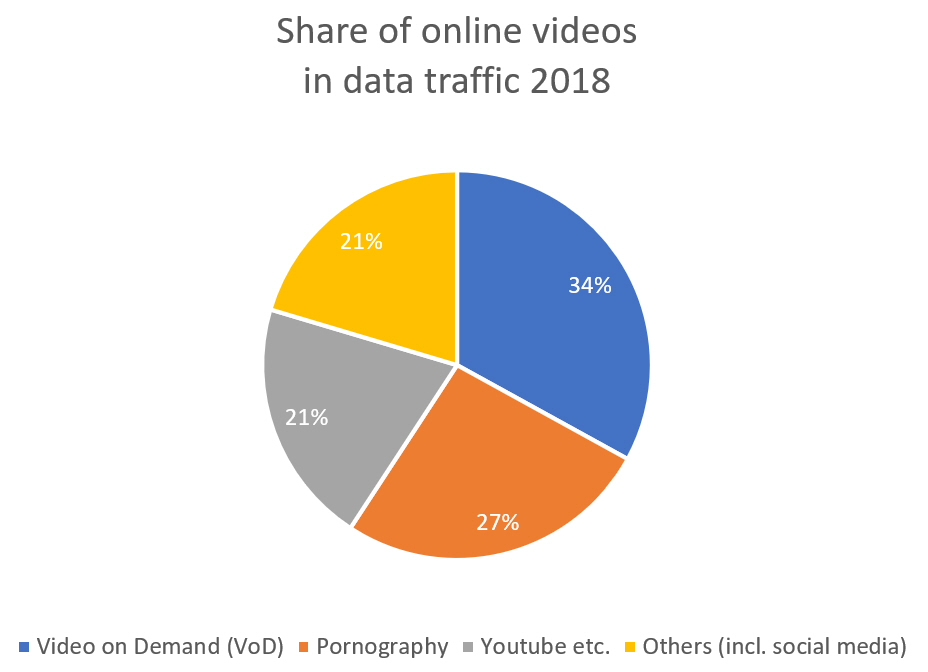
(Data source: The Shift Project, July 2019: Climate Crisis Report)

A golden future is also predicted for mobile “gaming”. Under the heading “Mobile cloud gaming – an evolving business opportunity”, Ericsson wrote in November 2020: “Mobile games already generate 50% of global gaming industry revenue. Providers of 5G networks can look forward to a $150 billion dollar market!3)According to the report by Capacity Media of September 30th, 2020: https://www.capacitymedia.com/articles/3826338
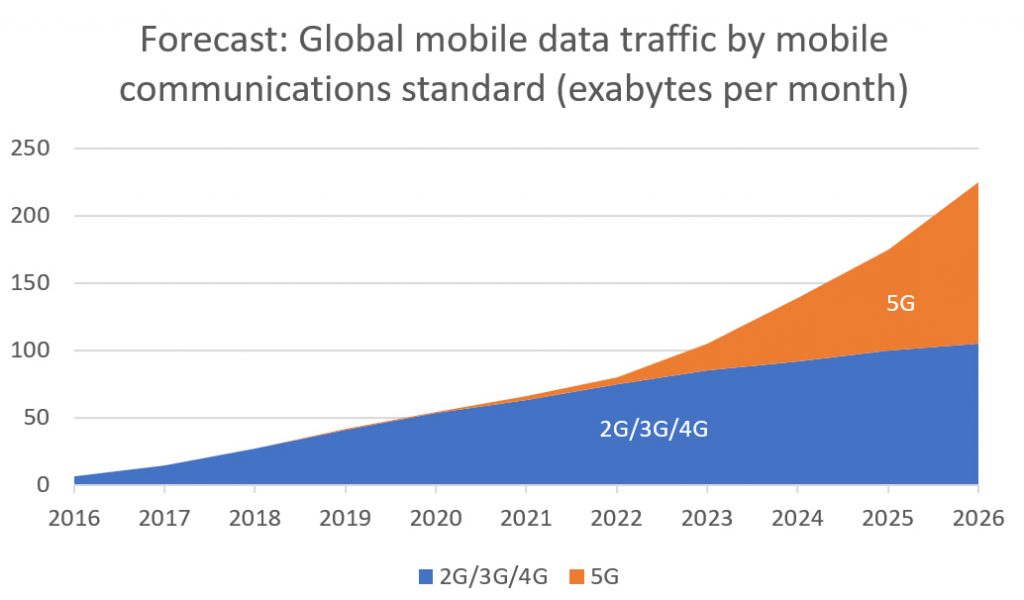
(Data source: Ericsson, November 2020: Ericsson Mobility Report)
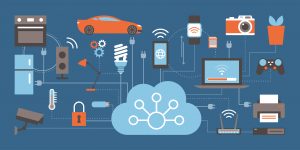
With 5G, the digitisation and establishment of the Internet of Things (IoT) will be greatly accelerated. Although digitalisation hardly appears in the statistics yet, the 5G specification makes people prick up their ears: It requires that one million end devices per square kilometre can be networked with each other. Direct connections between the devices should also be possible without having to make a diversion via a base antenna. The European Space Agency (ESA) writes on its website that up to 7 trillion terminals are to be expected worldwide – that would be around 1,000 devices per Earth citizen! You can and must think of everything as a terminal device: From the smartphone to the refrigerator and the self-driving car to the nano-chip in the brain4)The company Neuralink already experiments with chips implanted in the brains of monkeys and pigs. See for example https://de.rt.com/gesellschaft/112677-elon-musks-neuralink-startup-pflanzt-chip-affengehirn/ or https://futurezone.at/science/elon-musks-neuralink-implantiert-affen-einen-chip-fuer-videospiele/401175634 or in a baby’s nappy, which notifies the parents via an app when the nappy needs to be changed. Even the energy supply for these chips could be provided wirelessly via 5G networks, as the scientific journal “Scientific Reports“ states.5)Eid, Hester, Tentzeris (Januar 2021): 5G as a wireless power grid. https://www.nature.com/articles/s41598-020-79500-xThere are no limits to inventiveness. Whether all of this is conducive to the development of humanity is a completely different question – but ultimately the decisive one!
It is therefore not surprising that the researchers of The Shift Project concluded in their report on the climate crisis that “the practical implementation of digitalisation should not happen without a societal debate about its benefits”.6)The Shift Project (Juli 2019): Climate Crisis: The unsustainable use of online video A debate that is long overdue.
Electricity consumption is increasing
Behind every swipe on the display, every download or every online action are complex infrastructures with data centres, servers, clouds, networks, transmitters, etc. And these infrastructures all have a corresponding energy or power consumption. On the software side, increasingly complicated encryption solutions (e.g. blockchain) and security technologies (backup, redundancy) are needed to ensure data security. The two Swedish researchers Anders S. B. Andrae and Thomas Edler show that with increasing data volumes, the power consumption of the entire information and communication technology() sector will also increase massively7)Anders S. G. Andrae, Tomas Edler (2015): Global electricity usage of communication technology: Trends to 2030 By 2030, depending on the scenario, the increase in worldwide electricity consumption will be between 8% (best case) and 51% (worst case)!
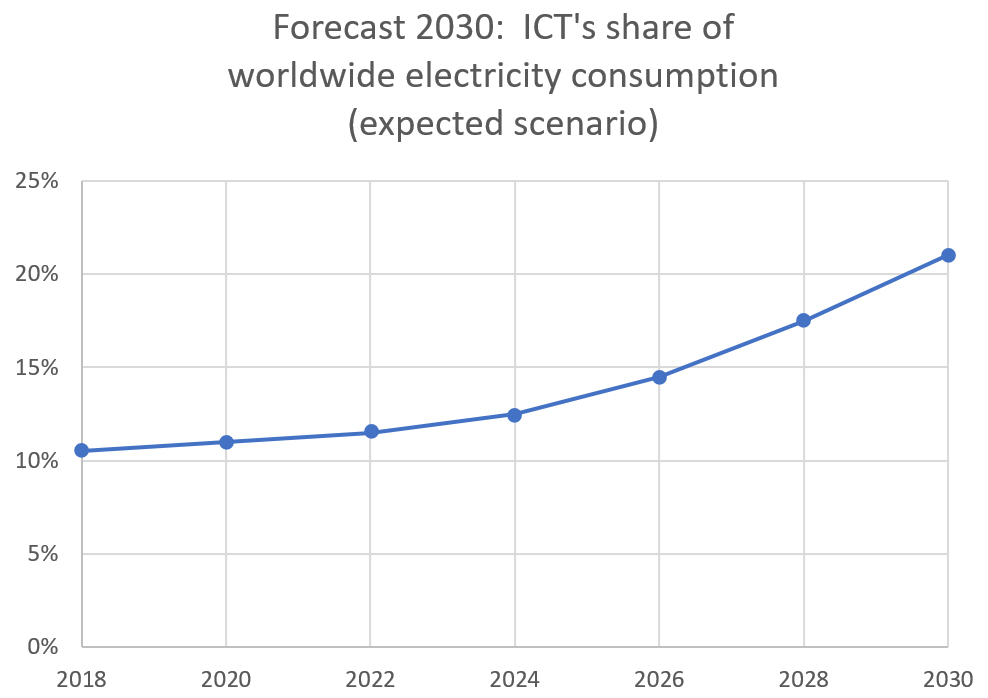
(Data source: Andrae + Edler, 2015: Global Electricity
usage of communication technology: Trends to 2030)
In countries, such as Ireland, that already have a strong server infrastructure and a wide range of cloud computing and data centre services, that growth will be even greater.
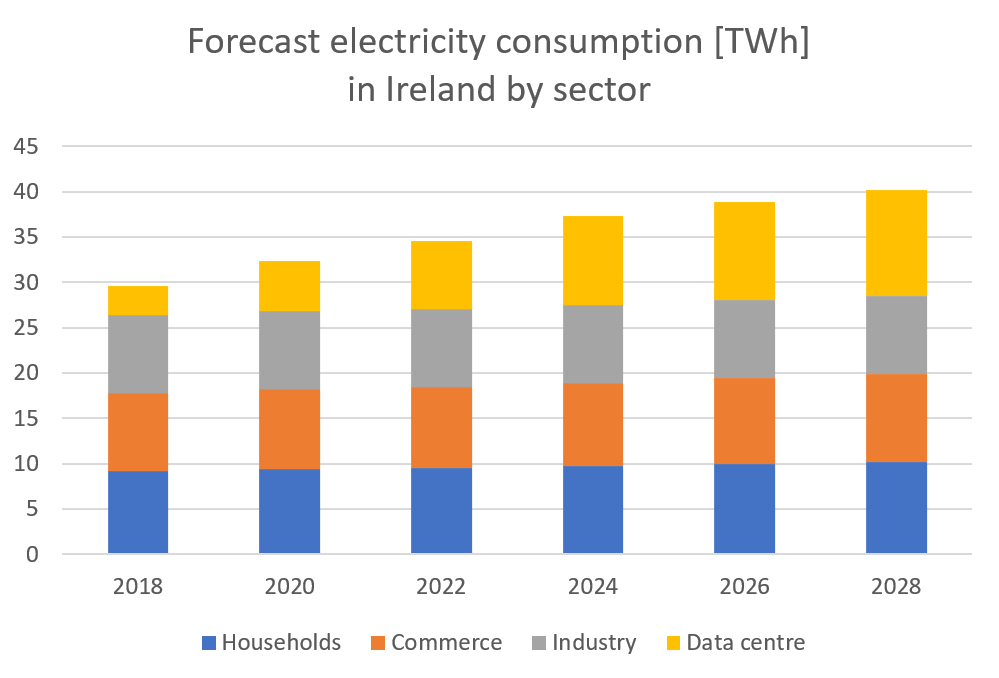
(Data source: International Energy Agency IEA, https://www.iea.org/commentaries/data-centres-and-energy-from-global-headlines-to-local-headaches)

ICT thus outed itself as the biggest growth driver of future electricity demand, which cannot be met by renewable energies either. Influential entrepreneurs like Elon Musk and Bill Gates are therefore seriously considering a renaissance of nuclear power. A scenario that defies common sense: have Chernobyl and Fukushima already been forgotten? Do we want to accumulate even more highly toxic and radioactive nuclear waste, the “disposal” of which remains unsolved and with which we are burdening our descendants with a 50,000-year mortgage?
Climate targets recede into the far distance
Against the backdrop of the Paris Climate Agreement, researchers from The Shift Project also looked at ICT’s greenhouse gas emissions. The results8)The Shift Project, March 2019: Lean ICT – Towards digital sobriety should be a warning to us:
- ICT’s share of global greenhouse gas emissions was 3.5% in 2018. Even then, this was almost twice as high as the emissions of aviation as a whole (2%).
- By 2025, ICT’s share of global greenhouse gas emissions will more than double to around 8%.
While aviation suffers a great deal of public criticism, hardly anything is heard about the greenhouse gas emissions of information technology. This could be a political calculation: if digitalisation is to be successfully implemented, it must not be caught in the crossfire of the currently strong environmental movement.
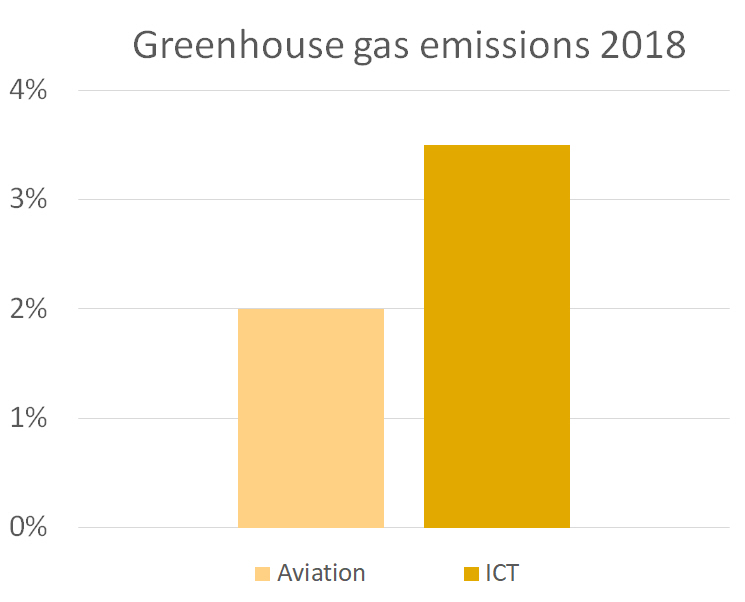
(Data Source: The Shift Project, March 2019: Lean ICT: Towards digital sobriety)
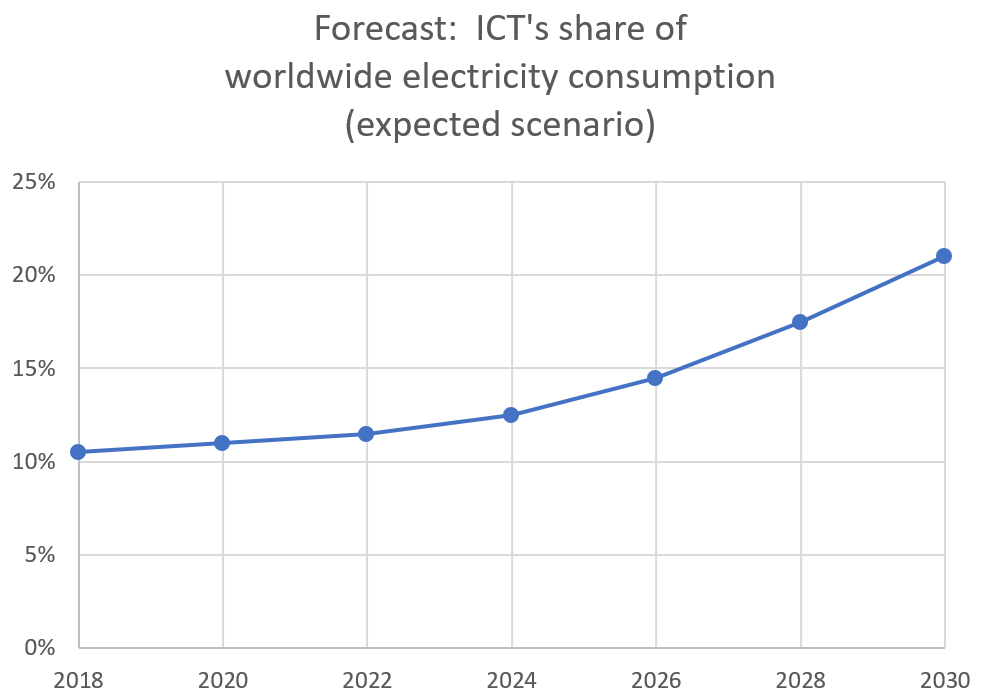
(Data Source: The Shift Project, March 2019: Lean ICT: Towards digital sobriety)
The demand for energy and the associated emissions are primarily based on the type of network used: The transmission via fibre optic cable (fibre to the home FTTH) requires up to ten times less energy than via the 5G network.9)Umweltbundesamt (September 2020): Energie- und Ressourceneffizienz digitaler Infrastrukturen. Ergebnisse des Forschungsprojektes «Green Cloud Computing» With the expansion of 5G, the efficiency and climate goals of the international community are thus becoming a distant prospect. This is why, for example, in somecities in China, the 5G antennas are set to – in effect, switched off – to reduce the high electricity consumption.10)[1] See also, for example, South China Morning Post (SCMP) of August 28th , 2020: https://www.scmp.com/abacus/tech/article/3098964/5g-towers-are-consuming-lot-energy-so-china-unicom-putting-some-them
Conflict Raw Materials
An estimated 1.4 billion smartphones were sold in 2019, almost ten times more than in 2009.11)According to Statista.com: Global smartphone shipments forecast from 2010 to 2023 (https://www.statista.com/statistics/263441/global-smartphone-shipments-forecast/) Today, a smartphone is only in use for about 2.7 years and is then replaced by a more modern device.12)See Greenpeace (2017) https://www.greenpeace.org/international/story/6913/what-10-years-of-smartphone-use-means-for-the-planet/. The continuous digitisation and the roll-out of 5G mobile networks will exacerbate this short-life trend, especially since 4G devices are not compatible with 5G. Equally, the entire supply infrastructure with computing and data centres, mobile base stations, networks and data lines etc. must be expanded and constantly renewed. And not surprisingly, work is already being done on 6G13)Research on 6G has been going on since 2017; data transfer rates of up to 400 Gbit/s should be possible. Germany alone has earmarked 700 million euros of funding for the development over the next 5 years. See Wikipedia entry at https://de.wikipedia.org/wiki/6G … The development cycles in the communications sector are becoming shorter and shorter and entail a massive additional consumption of valuable raw materials. These are built into the devices and infrastructure in the form of electronic components, cables, contacts and storage batteries. In particular, the material group of metals is problematic because many of them are rare or critical (in terms of social and ecological impacts in mining areas) or their reserves are already coming to an end. The problem is aggravated because technologies in the two growth areas of ICT and renewable energy production often share the same resources. In the figure below, the main metals used for ICT are marked in colour.
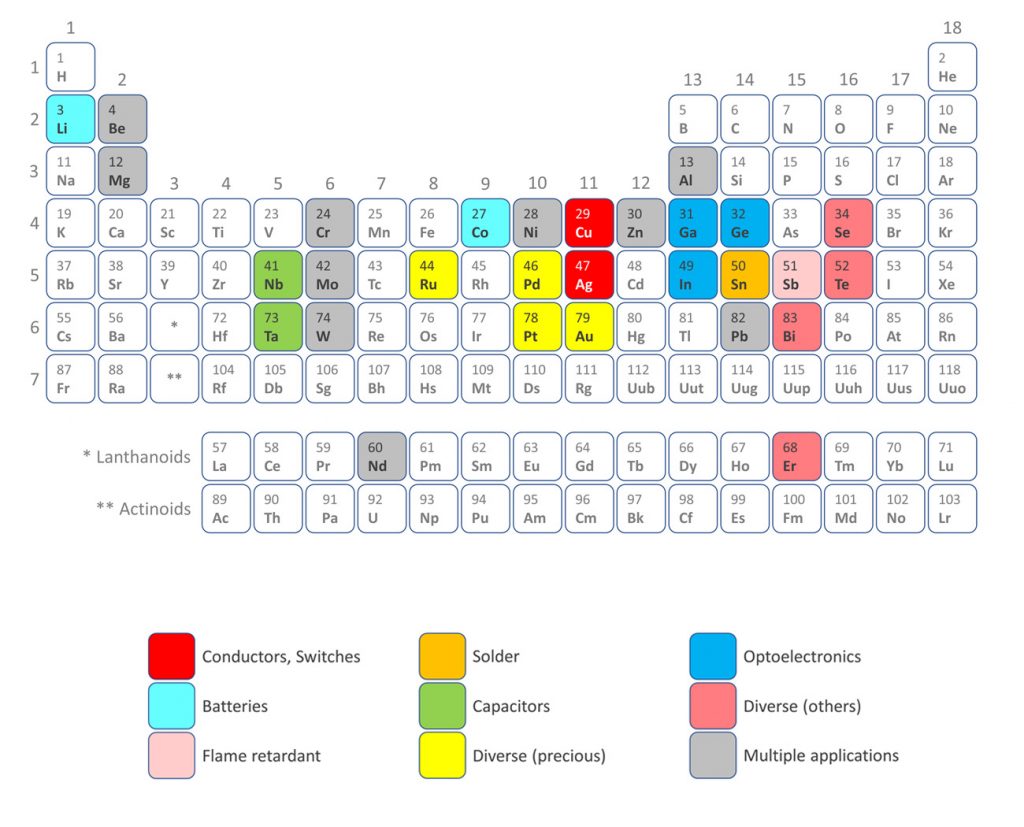
(Data Source: The Shift Project, March 2019: Lean ICT: Towards digital sobriety)
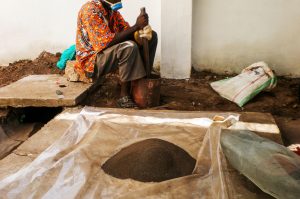
Several of these valuable raw materials are mined in areas where poor working conditions prevail and hardly any effective environmental standards apply. Because it is a multi-billion dollar business, armed conflicts are not uncommon – a circumstance that has also earned these rare natural resources the name conflict raw materials.14)See for this also entry in Wikipedia https://de.wikipedia.org/wiki/Konfliktrohstoff Recently, deep sea mining is also being promoted in order to tap the Earth’s last resources.15)See our Focus article “Unsatiable Greed: Through Deepsea mining to tap even our last resources “, https://www.naturalscience.org/news/2021/04/insatiable-greed-deep-sea-mining-to-tap-even-the-last-resources
At least 40 metals are built into a smartphone, in quantities ranging from a few milligrams to several grams in the double-digit range. With around 10 billion devices now produced, this is no small amount. Despite the great effort involved in mining ore and refining them into usable metals, only a very small proportion of these valuable materials are recycled at the end of their (short) useful life. Because of the often extremely low material concentrations, recycling is complex and costly. For comprehensive recycling to be possible at all, a worldwide collection logistics system would first have to be established.
The following figure shows the recycling rate of metals.
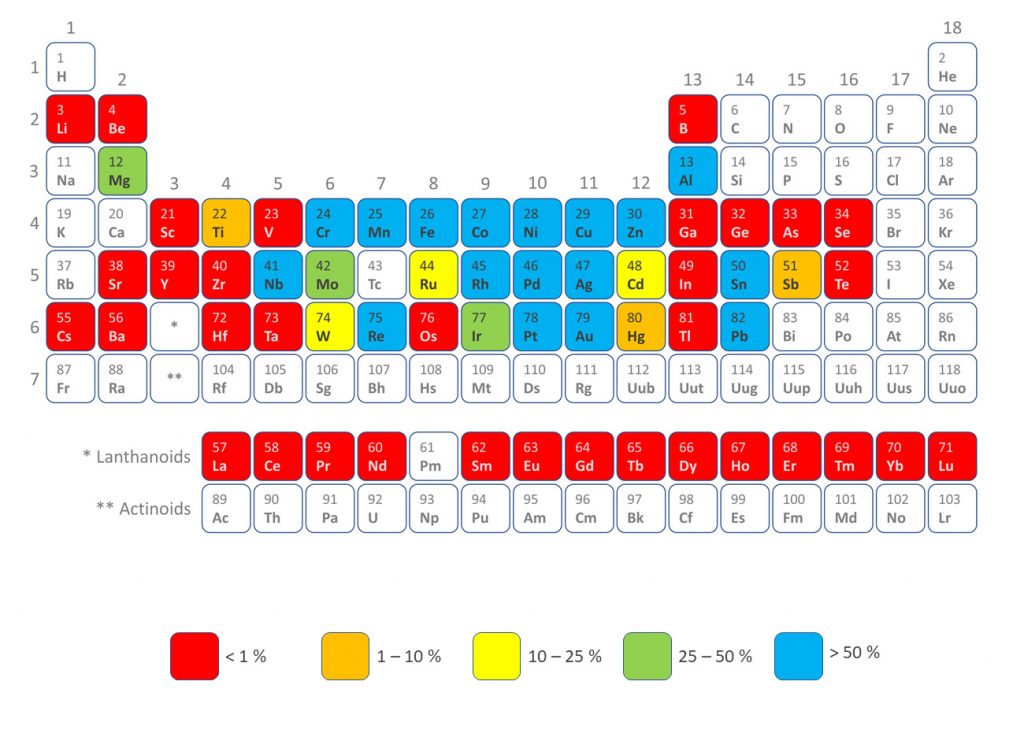
(Data Source: UNEP, 2011: Recycling Rates of Metals, a status report)
This situation could lead to an abrupt end of today’s technology if the growth in demand does not decrease or the recycling rate cannot be increased. The earth’s resources are finite: a circular economy that takes into account the reparability of devices is urgently needed.
Global warming and crumbling mountains
A still largely unnoticed factor could contribute to global warming: water reacts very sensitively to electromagnetic radiation. Independent research shows not only warming effects (as with microwave ovens), but also changes in the structure of water and the forces of order, which occur even at very low radiation intensities far below the official limits.16)Denise Ulrich (2020): Auswirkungen von Mobilfunk auf Wasser und Leben, https://www.elektrosmog-info.ch The frequency of 2.4 GHz used by popular radio services such as Bluetooth and WLAN corresponds exactly to the energy absorption maximum of water. The frequency band allocated to 5G in the 24 GHz range is also very close to an important water frequency: 23.8 GHz is the resonance frequency of water vapour. In school, we are taught that water vapour is the “strongest” greenhouse gas. But what happens to the water vapour in the atmosphere when it is excited by microwave radiation in precisely these important frequency ranges? 17)Meteorologists fear that technical radiation will severely disrupt the evaluation of satellite data regarding the water vapour content in the atmosphere. This will make reliable weather forecasts or climate predictions impossible. See report in the journal “Nature”: https://www.nature.com/articles/d41586-019-01305-4 Will the water vapour balance in the atmosphere be disturbed? Will global warming be accelerated?
Electromagnetic binding forces hold atoms, molecules and ultimately all matter together at their core.18)Gravitation, electromagnetism, weak interaction and strong interaction are the four basic forces of physics today. There are theories according to which all these basic forces can be traced back to electromagnetism In experiments with dried water droplets, whose sediments are examined under a dark-field microscope, it can be shown that water loses drag force under the influence of microwave radiation: The minerals contained in the water droplet are less strongly drawn into the centre during the drying process. This means an impairment of a force effect inherent in water19)See also to this our Focus article “Water- the Elixir of Life: Threatened by Radiation?” Could it be that increasing environmental events such as debris flow or rockfalls are not only due to changing climatic conditions, but are intensified by a weakening of the binding forces of water? This is where large and perhaps vital areas of research are opening up!
The main thing is “Smart”: Rebound effects and lack of added value
Most technical developments also aim to increase energy efficiency, i.e. to reduce energy consumption per unit of use. However, the rebound effect20)Rebound or backlash effect, also called boomerang effect. This refers to an effect that, due to its own success, cancels out the intended increase in efficiency nullifies efficiency gains: the development of 5G networks massively increases the availability of data, which opens up additional possibilities and creates new needs. This in turn leads to higher demand and blithely drives supply and network expansion. Without a doubt, this growth spiral is precisely the purpose of 5G, because it is supposed to make new data-intensive applications possible in the first place. The competitive situation of globally active companies such as Amazon or SpaceX, which are in the process of building their own satellite-based 5G and internet networks, is further fuelling the arms race.21)See also our Video and Focus article “5G Satellites: The World in a Radiation Cage” From a macroeconomic perspective, however, the conclusion is sobering: So far, there is no evidence that investments in digitalisation have had a positive impact on growth or productivity, according to researchers from The Shift Project.22)Quoting the 2019 Lean ICT Report: “The expected impact of digital transformation on growth and productivity remains invisible in developed countries over the past 5 years. The OECD growth rate remains stable around 2%, while annual digital spending growth has increased from 3% to 5%.”
Despite the negative effects, digitalisation is being pushed forward almost blindly. With catchwords like SmartHome or SmartMobility, it is touted as the saviour and intelligent servant of humanity that will solve our environmental problems. Even this is wrong: In 2019, ETH Zurich showed in a study that traffic will by no means decrease with autonomous (self-driving) vehicles, but will actually increase.23)Hörl, Becker, Dubernet, Axhausen, ETH Zürich (Februar 2019): Induzierter Verkehr durch autonome Fahrzeuge: Eine Abschätzung Intelligent planning systems could indeed improve the utilisation of vehicles and avoid empty runs. But because the service would be so easy and convenient to use, this form of mobility would be very attractive: even children could call an “autonomous taxi”, and one could work, play online, watch films or do other things while driving.24)Because an autonomous vehicle must also function safely in a radio dead zone or if the radio connection fails, all safety-relevant sensors and components must be located in the vehicle it must also be possible to interact with other vehicles without a higher-level radio network. The wireless network is therefore only used in a subsidiary manner, namely for the purpose of data acquisition (location, speed, traffic jam reports, danger spots, etc.…).
It is no different with networking in one’s own four walls – the SmartHome. In a study published in 2018 by the German Borderstep Institute for Innovation and Sustainability, the authors come to the key conclusion that “in many product groups, it remains open whether additional connectivity creates actual added value for consumers”.25)Dr. Ralph Hintermann und Simon Hinterholzer, Borderstep Institut für Innovation und Nachhaltigkeit, (2018): Smarte Rahmenbedingungen für Energie- und Ressourceneinsparungen bei vernetzten Haushaltsprodukten. Kurzstudie im Auftrag des Bund für Umwelt und Naturschutz Deutschland e. V. (BUND Smart home technologies would even increase household electricity consumption by around 8% (330 kWh). The additionally installed electronics therefore consume a lot of electricity and collect even more data: Built-in microphones, motion detectors, cameras, temperature or humidity sensors produce vast amounts of bits and bytes, which are collected, processed and stored by the manufacturers. This makes it easy to spy on users or to generate behavioural profiles from them in order to create new and often pointless offers. And as if these were not enough disadvantages, the health of the residents of a smart home is also damaged. There are numerous scientific studies on the many health effects of wireless radiation, ranging from lack of concentration, headaches, tinnitus, oxidative cell stress and a weakened immune system to programmed cell death and cancer.26)See also, e.g., the study database https://www.emfdata.org or information from the German consumer protection organisation https://www.diagnose-funk.org.
Who does the SmartCity serve?
The many smart applications and projects finally culminate in the SmartCity, a “dazzlingly colourful magic bag that promises everyone what they want to hear: Innovation and modern city marketing,efficient administration and citizen participation, sustainability and climate protection, security and convenience”, as Peter Hensinger puts it in “Die Drei” magazine.27)Article by Peter Hensinger in the journal „Die Drei“, volume 4/2019: Die digitalisierte „Smart City“ – Auf dem Weg zum konditionierten Untertan No wonder the SmartCity is an important building block for the climate movement. But do we really know what we are getting ourselves into? The handbook for municipalities “SmartCity becomes reality”28)Michael Jaekel (2018): SmartCity wird Realitätclarifies: “If you want to develop a better society, you need a complete picture of social interactions. With the possibilities of BigData management, we know precisely who interacts with whom, when, where […] The central element is real-time monitoring of the system parameters of a SmartCity, combined with working out the optimal decision in response to changing system conditions.” The Smart City Charter of Germany, for example, shows that these are not simply fantasy scenarios29)Bundesministerium für Umwelt, Naturschutz, Bau und Reaktorsicherheit sowie Bundesinstitut für Bau-, Stadt- und Raumforschung (Stand Mai 2017): Smart City Charta. Digitale Transformation in den Kommunen nachhaltig gestalten. The Finn Roope Mokka writes the following about the “visions of a hyper-connected planet”: “Post-voting society:30)Loosely translated, this means: A society in which elections (material or personal) are no longer necessary. Since we know exactly what people do and want, there is less need for elections, majority finding or voting. Behavioural data can replace democracy as the social feedback system.” Abolition of democracy, surveillance and manipulation under the pretext of progress and climate protection? Is this just an unrealistic worst-case scenario? Hardly. In China, 5G is already being used by the police as a surveillance tool.31)World Future Council (2020): Die Auswirkungen des 5G Netz-Ausbaus auf Energieverbrauch, Klimaschutz und die Einführung weiterer Überwachungstechniken. Siehe auch https://www.5g-anbieter.info/5g-news/5g-brillen-polizei-identifizierung Vigilance is urgently needed. It is easier to destroy hard-earned achievements like democracy and freedom than to rebuild them. It would do every city and municipality good to take an in-depth look at the term and its implications before adopting SmartCity.
Man is part of the solution

Man will always leave an ecological footprint. Through breathing alone, humans permanently emit carbon dioxide CO2, which is considered the climate killer. In the whole environmental and climate movement, however, it is sometimes forgotten that humans, as the “crown of creation”, are probably the most important part of the Earth’s ecosystem. Without humans as pupils, there would be no need for the schoolroom Earth. Of course, if man destroys his home planet, he will not be served.
It therefore seems to be the great task of humanity to allow itself the greatest possible individual freedom of development without bleeding the planet dry. Human welfare is thus part of the solution and not the problem. The use of technology cannot increase endlessly. It borders on sheer ignorance to think that one growth (energy and resource consumption, environmental damage) can be stopped by another growth (digitalisation). In the better case, the problems simply shift from one area to the other; in the worst case, they add up. Instead of blind digitalisation hype, we need a new sobriety to see technology for what it really is: a tool that can provide wonderful services when used in the right way. Which of these services we really need, for the good of humanity and the whole planet, and how we use technology so that it serves not only economic and political interests, but all people, is something we urgently need to think about. As individuals and as a society, we cannot avoid having this discussion and acting accordingly.
References
| ↑1 | Screen resolutions and video standards have developed considerably in recent decades. Early computer screens had a resolution of 640 x 480 pixels (video standard VGA). Today’s smartphones have a resolution of around 1440 x 3200 pixels, TV sets even up to 8192 x 4320 (8K resolution). The video qualities of the streaming services have changed accordingly: While a few kilobytes were initially sufficient (e.g. YouTube 144p), today several megabytes (e.g. Netflix Ultra HD, 4K) have to be transmitted per second. And there is no end in sight to this development. |
|---|---|
| ↑2 | The Shift Project, July 2019: Climate Crisis: The unsustainable use of online video https://theshiftproject.org/en/article/unsustainable-use-online-video/ |
| ↑3 | According to the report by Capacity Media of September 30th, 2020: https://www.capacitymedia.com/articles/3826338 |
| ↑4 | The company Neuralink already experiments with chips implanted in the brains of monkeys and pigs. See for example https://de.rt.com/gesellschaft/112677-elon-musks-neuralink-startup-pflanzt-chip-affengehirn/ or https://futurezone.at/science/elon-musks-neuralink-implantiert-affen-einen-chip-fuer-videospiele/401175634 |
| ↑5 | Eid, Hester, Tentzeris (Januar 2021): 5G as a wireless power grid. https://www.nature.com/articles/s41598-020-79500-x |
| ↑6 | The Shift Project (Juli 2019): Climate Crisis: The unsustainable use of online video |
| ↑7 | Anders S. G. Andrae, Tomas Edler (2015): Global electricity usage of communication technology: Trends to 2030 |
| ↑8 | The Shift Project, March 2019: Lean ICT – Towards digital sobriety |
| ↑9 | Umweltbundesamt (September 2020): Energie- und Ressourceneffizienz digitaler Infrastrukturen. Ergebnisse des Forschungsprojektes «Green Cloud Computing» |
| ↑10 | [1] See also, for example, South China Morning Post (SCMP) of August 28th , 2020: https://www.scmp.com/abacus/tech/article/3098964/5g-towers-are-consuming-lot-energy-so-china-unicom-putting-some-them |
| ↑11 | According to Statista.com: Global smartphone shipments forecast from 2010 to 2023 (https://www.statista.com/statistics/263441/global-smartphone-shipments-forecast/ |
| ↑12 | See Greenpeace (2017) https://www.greenpeace.org/international/story/6913/what-10-years-of-smartphone-use-means-for-the-planet/. |
| ↑13 | Research on 6G has been going on since 2017; data transfer rates of up to 400 Gbit/s should be possible. Germany alone has earmarked 700 million euros of funding for the development over the next 5 years. See Wikipedia entry at https://de.wikipedia.org/wiki/6G |
| ↑14 | See for this also entry in Wikipedia https://de.wikipedia.org/wiki/Konfliktrohstoff |
| ↑15 | See our Focus article “Unsatiable Greed: Through Deepsea mining to tap even our last resources “, https://www.naturalscience.org/news/2021/04/insatiable-greed-deep-sea-mining-to-tap-even-the-last-resources |
| ↑16 | Denise Ulrich (2020): Auswirkungen von Mobilfunk auf Wasser und Leben, https://www.elektrosmog-info.ch |
| ↑17 | Meteorologists fear that technical radiation will severely disrupt the evaluation of satellite data regarding the water vapour content in the atmosphere. This will make reliable weather forecasts or climate predictions impossible. See report in the journal “Nature”: https://www.nature.com/articles/d41586-019-01305-4 |
| ↑18 | Gravitation, electromagnetism, weak interaction and strong interaction are the four basic forces of physics today. There are theories according to which all these basic forces can be traced back to electromagnetism |
| ↑19 | See also to this our Focus article “Water- the Elixir of Life: Threatened by Radiation?” |
| ↑20 | Rebound or backlash effect, also called boomerang effect. This refers to an effect that, due to its own success, cancels out the intended increase in efficiency |
| ↑21 | See also our Video and Focus article “5G Satellites: The World in a Radiation Cage” |
| ↑22 | Quoting the 2019 Lean ICT Report: “The expected impact of digital transformation on growth and productivity remains invisible in developed countries over the past 5 years. The OECD growth rate remains stable around 2%, while annual digital spending growth has increased from 3% to 5%.” |
| ↑23 | Hörl, Becker, Dubernet, Axhausen, ETH Zürich (Februar 2019): Induzierter Verkehr durch autonome Fahrzeuge: Eine Abschätzung |
| ↑24 | Because an autonomous vehicle must also function safely in a radio dead zone or if the radio connection fails, all safety-relevant sensors and components must be located in the vehicle it must also be possible to interact with other vehicles without a higher-level radio network. The wireless network is therefore only used in a subsidiary manner, namely for the purpose of data acquisition (location, speed, traffic jam reports, danger spots, etc.…). |
| ↑25 | Dr. Ralph Hintermann und Simon Hinterholzer, Borderstep Institut für Innovation und Nachhaltigkeit, (2018): Smarte Rahmenbedingungen für Energie- und Ressourceneinsparungen bei vernetzten Haushaltsprodukten. Kurzstudie im Auftrag des Bund für Umwelt und Naturschutz Deutschland e. V. (BUND |
| ↑26 | See also, e.g., the study database https://www.emfdata.org or information from the German consumer protection organisation https://www.diagnose-funk.org. |
| ↑27 | Article by Peter Hensinger in the journal „Die Drei“, volume 4/2019: Die digitalisierte „Smart City“ – Auf dem Weg zum konditionierten Untertan |
| ↑28 | Michael Jaekel (2018): SmartCity wird Realität |
| ↑29 | Bundesministerium für Umwelt, Naturschutz, Bau und Reaktorsicherheit sowie Bundesinstitut für Bau-, Stadt- und Raumforschung (Stand Mai 2017): Smart City Charta. Digitale Transformation in den Kommunen nachhaltig gestalten. |
| ↑30 | Loosely translated, this means: A society in which elections (material or personal) are no longer necessary. |
| ↑31 | World Future Council (2020): Die Auswirkungen des 5G Netz-Ausbaus auf Energieverbrauch, Klimaschutz und die Einführung weiterer Überwachungstechniken. Siehe auch https://www.5g-anbieter.info/5g-news/5g-brillen-polizei-identifizierung |








